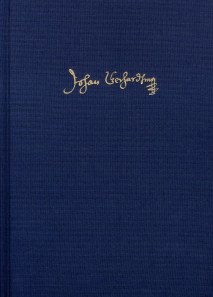Johann Gerhard: Exercitium Pietatis Quotidianum Quadripartitum (1612)
Gerhard’s book of prayer was published in 1612 for the first time in Latin. There were 86 editions of this work, it was translated into 13 languages and had an international and interdenominational impact. This edition provides a parallel version of the Latin text and the contemporary German translation. The text is made accessible by text-critical annotations and evidence of biblical quotations as well as references to ancient Christian and medieval sources. The appendix contains all of the spiritual songs which the Szczecin pastor Friedrich Fabricius (1642–1703) included in his new edition of the ›Exercitium‹ from the year 1688. There is also an introduction to the origins and the impact.
Reviews
»Die vorliegende, in Leinen gebundene, recht edle Ausgabe in der wissenschaftlich und ästhetisch herausragenden Reihe Doctrina et Pietas bietet auf gut 200 Seiten den lateinischen Text und eine zeitgenössische Übersetzung im Paralleldruck. [...] Im Ganzen ist dies ein höchst beeindruckendes Buch.«
»Erstmals wird hiermit ein bedeutendes, auch unter Fachleuten höchst selten bekanntes lutherisches Gebetbuch der nachreformatorischen Zeit in historisch-kritischer Edition zugänglich gemacht, was für die Frühneuzeitforschung hinsichtlich der Gebetsliteratur zweifellos einen beachtlichen Gewinn bedeutet.«
»This edition of Gerhard’s Exercitium is an important first step to filling a gap within the published resources available to modern researchers interested in delving more deeply into the religious and devotional currents of the early modern Christianity of the seventeenth century. It will be of use for social historians, scholars of religion, and historical and practical theologians alike.«
All volumes
- Gerhard: Tractatus de legitima scripturae sacrae interpretatione (1610) – available
- Gerhard: Exercitium Pietatis Quotidianum Quadripartitum (1612) – available
- Bibliotheca Gerhardina – available
- Gerhard: Sämtliche Leichenpredigten – available
- Bibliographia Gerhardina (1601–2002) – available
- Gerhard: Postilla (1613), Teile 1-5 – available
- Gerhard: Erklährung der Historien des Leidens vnnd Sterbens vnsers HErrn Christi Jesu nach den vier Evangelisten (1611) – available
- Gerhard: Enchiridion consolatorium morti ac tentationibus in agone mortis opponendum (1611) – available
- Gerhard: Ein vnd Fünfftzig Gottselige / Christliche Evangelische Andachten / oder Geistreiche Betrachtungen – available
- Gerhard: Meditationes Sacrae (1606/07) – available
- Gerhard: Meditationes Sacrae (1603/04) – available
- Steiger: Johann Gerhard (1582–1637) – available
- Subject Areas
- New Publications
- ---
- Critical Editions
- Collected Works
- Series
- Arbeiten und Editionen zur Mittleren Deutschen Literatur
- Aufklärung und Revolution
- Böhme-Forschungen
- Bibliothek 1800
- Clavis Pansophiae
- Collegium Philosophicum
- Commentaria in Aristotelem Graeca
- Doctrina et Pietas
- Editionen zur Frühen Neuzeit
- Elea
- Europäische Literatur der Frühen Neuzeit
- exempla aesthetica
- Forschungen und Materialien zur Universitätsgeschichte
- Forschungen und Materialien zur deutschen Aufklärung
- Freidenker der europäischen Aufklärung
- Freud heute
- frommann-holzboog Studientexte
- Fundamenta Historica
- Grammatica Speculativa
- Grammatica Universalis
- Kultur und Gesellschaft
- legenda
- Judith Le Soldat heute
- Medizin und Philosophie
- Melanchthon-Schriften der Stadt Bretten
- Mystik in Geschichte und Gegenwart
- Natur und Philosophie
- Neuzeit im Aufbau
- Philosophie interkulturell
- Philosophische Clandestina der deutschen Aufklärung
- Der Platonismus in der Antike
- Politische Philosophie und Rechtstheorie des Mittelalters und der Neuzeit
- problemata
- Psychoanalysis International
- Quaestiones
- Schellingiana
- Specula
- Spekulation und Erfahrung
- Supplementum Platonicum
- Volksaufklärung
- Werkstatt Bionik und Evolutionstechnik
- Bibliographies and Reference Books
- Allgemeine Zeitschrift für Philosophie
- AZP Beihefte
- Jahrbuch der Psychoanalyse
- JP Beihefte
- Steiner Studies
- Open-Access
- Single volumes
- eBooks
- Special Offers
- ---
- Authors
- Publishing house
- Links / Partner
- Paths to Philosophy
